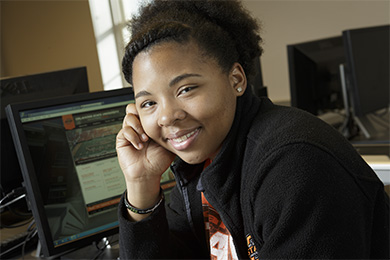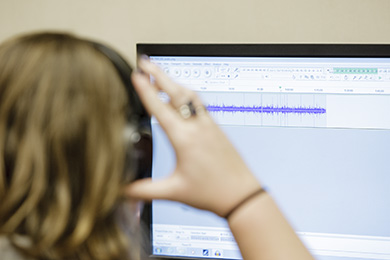Engagement Strategies
Keeping Students Engaged in Physically Distanced Classes
It will likely be challenging to engage students in our face-to-face classes in ways similar to those of the past. First, students may be seated several feet apart while wearing face coverings. Second, there is a reasonable chance that while one group of students is with you in the face-to-face session, another group is attending virtually—either synchronously or asynchronously. Without microphones placed throughout the room, it is nearly impossible for virtual students to hear what students in the room are saying. This means small-group and whole-class discussions will likely not work well. Unfortunately, one-way delivery of information is also not likely not going to be the best use of your face-to-face class time with students (McGee & Reis, 2012), especially if this time is significantly decreased. Given these very definite possibilities, let’s consider other ideas that can be used to keep students engaged and connected.
Online Microlectures

Making Effective Use of Your Face-To-Face Class Times
It is always important for us to consider effective use of face-to-face class time, but it seems especially important now that we might only see a student in our physical classroom space one day a week. Suddenly this contact feels especially important and we want to make the most of this time so that all students benefit from these limited face-to-face experiences.
Practice and Feedback—We tend to think of active learning as being physical, but active learning is also identified as something that causes students to think deeply about a subject (Bonwell & Eison, 1991). Supplying problems or offering case studies and scenarios in which students apply the content gained via readings or microlecture videos is engaging and active. Students can attempt to solve a problem on their own and then see how you approach it or they can attempt a problem and receive checkpoint answers to compare with their own. They can highlight the notable items in a scenario before you share what you considered important. They can watch a brief video clip and analyze it based on a particular theory or model before you share your work on this task. In each situation, students are able to practice a task and receive feedback by comparing their attempts with yours.
Demonstrate Models of Organization—Novice learners rarely have the complex mental structures of experts (Ambrose, et al., 2010). Use face-to-face time to help students create more robust mental connections. Constructing time lines, mind maps, concept maps, or completing other graphic organizers pushes students to connect ideas across content and classes. Afraid that students are thinking formulaically rather than conceptually about problem types? Post three problems and ask them to note commonalities and differences. Do you suspect that students are relying too heavily on memorization? Name a theory and have them provide real-life examples. All of these ideas help students make deeper connections that create stronger mental models.
Pose Interesting Questions—Generate interest and gain insight into students’ thinking through the use of interesting questions and a student response system. There are a variety of systems available (iClicker, Turning Point Clickers, TopHat, and Poll Everywhere, etc.), and some instructors on campus even use colored pieces of cardstock as a low-tech version. There are many types of questions that can be used to instill curiosity and promote deep thinking about content. An important caveat: If your face-to-face session simply repeats the content of readings or microlecture videos, students will learn that they do not have to complete those readings or videos.
Just-In-Time-Teaching— Prior to class, have students respond to a question that reveals their current thinking or that gauges their current areas of struggle. Then use this information as the guide for your face-to-face teaching. For example, if a number of students express confusion about a particular concept, begin class by offering further explanation. Or, if many students miss a particular problem on a recent quiz, provide similar types of problems that can be practiced in class when you are there to offer support.
Offer a Challenge that Prepares Students for Future Learning—Build anticipation for upcoming content by sharing a challenge that can be addressed once students learn the information contained in upcoming content. Research suggests that even when students incorrectly try a solution or make inaccurate predictions, their learning is strengthened in the attempt (Brown, et al., 2014).
Keeping Students Engaged Online

Synchronous Online Practice—Bring groups of students together in real-time to work with you. You can use Microsoft Teams, Zoom, or the Conferences feature in Canvas to share information virtually with students in real time. If you use the whiteboard feature or a whiteboard app, students can watch as you solve a problem or annotate a diagram and they can also be working simultaneously with you. If students have questions, they can easily ask them in these small groups, especially when you intersperse, “What questions do you have?” throughout your session.
Engaging with the Content—Regardless of the course structure, we want students to engage deeply with the content. How can we ensure that students watch the videos and complete the readings while thinking critically about the content? Low-stakes quizzes are one way to ensure that our course’s materials are prioritized. Another mechanism for helping students think meaningfully about the content is through the use of “notes with gaps” or note-taking guides. Not only does a notetaking guide help students recognize key ideas, it also provides a structure that was created by an expert in the field. In this way, your expert mental connections become transparent for students. Dr. Kristi Dickey’s presentation Creating Deep Learning Experiences: Helping Students Make Connections, offers theory (Part I & Part II), teaching strategies (Part III), and an excellent example (Part IV and Note-Taking Guide) of how this could be structured.
Build in Early Success—Structure the course in such a way that material builds over time. Include easier assignments near the start of the semester that allow for student success and that prepare students for future assignments. Does the course have a huge capstone project? Look for ways to break it into manageable chunks (see Frequent Feedback section). Is there a challenging paper that students will write? Perhaps one course assignment is a draft of this paper and a second course assignment is the final version. Students can receive a small number of points for the draft and receive feedback from you. Then they have the opportunity to revise and improve prior to submitting the final draft which is worth a significant number of points. Similarly, students could receive peer feedback on an assignment prior to submitting the final version.
Frequent Feedback—It is easy to feel isolated as a student in an online environment. When the feelings of isolation combine with feelings of uncertainty, it becomes very easy to disengage. However, as an instructor you can combat this by providing frequent feedback. Your feedback helps students feel supported and encourages them to stay on track. Comment on students’ posts on the discussion board. Create mini-assignments that build to a final complete assignment—such as several portions of a paper that lead to the final complete draft—and offer feedback on each of these smaller assignments. Offer optional synchronous sessions that students may attend to receive additional support. When you notice a common misconception, post a Canvas announcement that will keep students from going too far astray.
Message Students Who…—In Canvas, you can message students through the Gradebook based on certain criteria. One option is “Message students who scored more than…” and could be used to congratulate the hard work of those who passed the first exam. Another option is “Message students who scored less than…” and could be used to remind students who didn’t do as well that they can still pass the course and that you are willing to help them. Do you notice that several students have not turned in an assignment? You can “Message students who have not submitted the assignment” and tell them that you are looking forward to seeing their work.
Keeping Students Connected

Build Community—With the new normal of social distancing, facial coverings, and online instruction, we may have to deliberately strive to connect students with one another. What once took place naturally over the course of a semester may now have to be purposeful in implementation. A low-stakes assignment at the start of the semester that requires students to introduce themselves via Canvas is likely a worthwhile strategy. Asking students to create a brief video, a PowerPoint slide, or “one-pager” introduction to post in the Canvas discussion board will help students get to know each other.
Create Small Groups—In Canvas, the instructor can create small groups of students either manually (group members are purposely selected) or automatically (group members are randomly assigned). Many of the small group techniques that have previously been part of our face-to-face instruction will likely need to be tweaked and completed online, but they could still be worthwhile. For example, perhaps small groups are tasked with completing an item prior to the face-to-face session in order to prep for an extension of the content, or maybe each member of the group creates a concept map that is shared and discussed with groupmates at the conclusion of a unit of study or as exam review.
Use Student Teams—If your class is socially distanced in order to decrease density, student teams might provide a nice mechanism of support. Imagine that in your MWF class, 1/3 of the students attend the face-to-face class on Monday, 1/3 attend Wednesday, and 1/3 attend Friday. Student teams made up of one Monday person, one Wednesday person, and one Friday person would offer a connection across face-to-face and virtual students. During class time, you could ask your face-to-face students if their virtual teammates have any questions that need to be addressed. Student teams could also virtually connect through collaborative reading and note-taking. Since students can also create groups in Canvas, this would provide a space for them to connect with one another on a regular basis.
If you are planning to use virtual office hours, you could ask different teams to attend at particular times via Microsoft Teams, Zoom, or Canvas Conferences and this would allow for interaction that doesn’t require use of a mask.
Online Discussion Boards—Discussion boards in Canvas provide a mechanism for engaging students in virtual conversations. For those teaching classes that typically involve significant amounts of student discussion, discussion boards are one way to continue such practice in hybrid and online courses. However, it is important to consider effective discussion board practices so this does not feel like busywork for students. Having an awareness of facilitating robust discussions, fostering student participation on discussion boards, and common discussion board challenges are important considerations before assigning this type of work.
